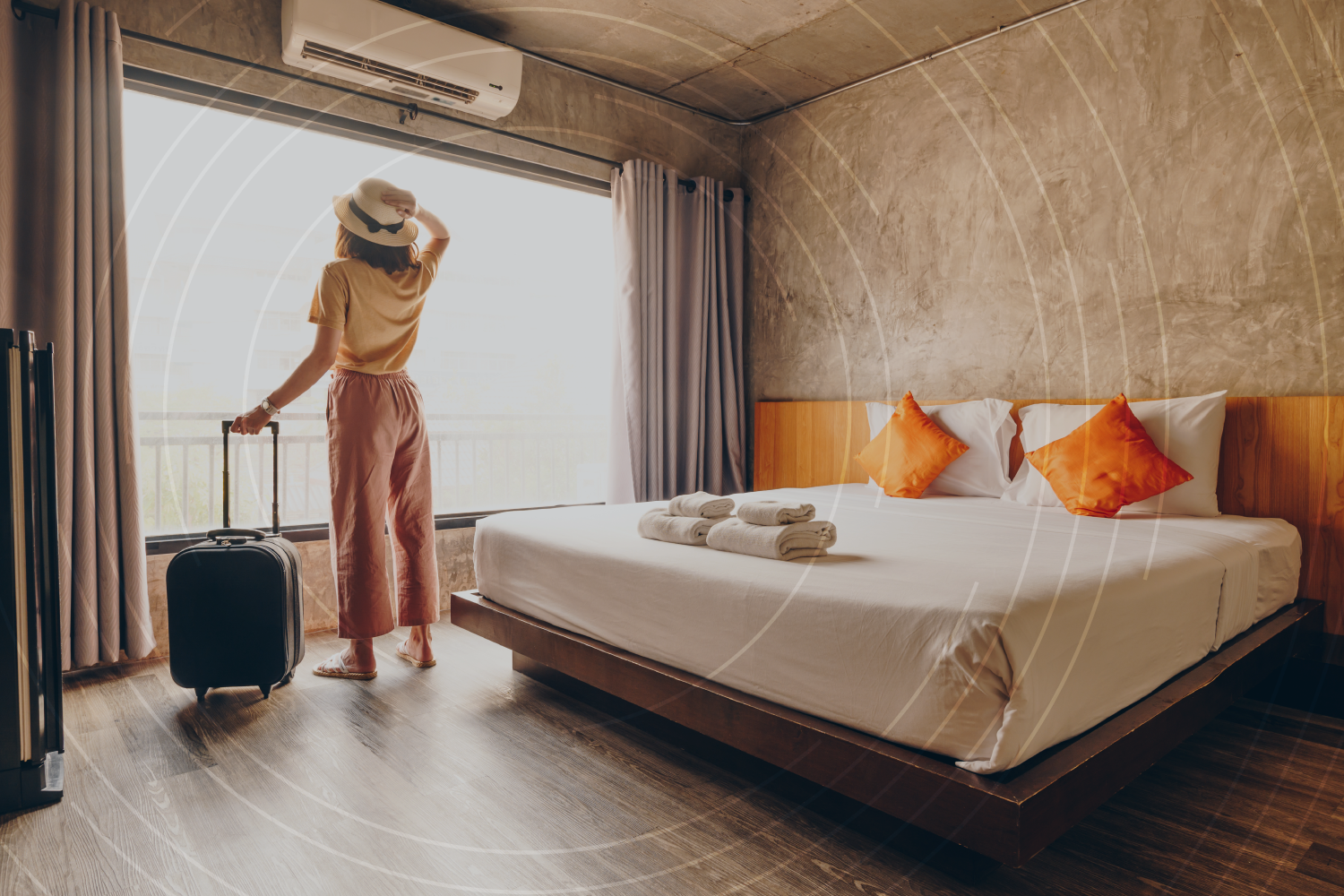
There was a time when piling into the station wagon and braving the open road without A/C was synonymous with family vacations. The first installments of the National Lampoon’s Family Vacation series was built on America’s shared gripes surrounding the love-to-hate family road trip. Since then, aviation has reigned supreme as travelers seek to explore far and wide.Thanks to COVID-19, that world may no longer be.
Travelers Don’t Trust Flights
The Los Angeles Times reported that as of April 15, air travel was down by 95%. At first glance, you might assume this sharp decline has to do with stay-at-home orders. But the departure from flight-focused travel runs deeper than that.Harris Poll surveyed 2,039 nationally representative adults and found that despite new policies like mandatory mask-wearing, 48% of respondents would not feel comfortable flying until the COVID-19 pandemic is fully behind us. 12% of those also reported that they wouldn’t fly until they didn’t have to wear a mask. Airlines are also forecasting increased wait times as they execute on enhanced safety procedures, which 79% of respondents said would further deter them from flying.Re-enter the road trip.
Big Brands Aren’t Relying on Flying
Hospitality heavyweights don’t expect air travel to be their ticket to recovery. As the popularity of drive-to vacations remains on the rise, brands like Hilton and Pebblebrook expect that their leisure business will be the first to rebound, especially for their limited-service brands.As reported in Yahoo Finance’s coverage of Hilton’s first-quarter earnings call, Hilton CEO Christopher Nassetta said, “Those that are willing to travel are only willing to go so far from home. We will show recovery at a faster pace because we can accommodate the kind of demand airlines can’t.”Domestic aviation research group BCG has forecasted five possible recovery models for air travel, but hospitality industry leaders agree that hotel recovery isn’t contingent on airlines.Pebblebrook Hotel Trust CEO Jon Bortz echoed this sentiment in a recent conversation with Skift. He said, “We think leisure travel comes back first, as those travelers are not accountable to anyone but themselves. People are cooped up and anxious to get on the road. I think we’ll see more drive-to than fly-to initially.”
What This Means for Your Hotel
Early trends in travel post-COVID-19 indicated that extended stay, economy hotels may fare best as these property types are often in more rural, road trip-friendly locations that haven’t been a coronavirus hotspot. But Bortz thinks this trend could be a false positive.In that same conversation with Skift, he noted that “Drive-to locations will probably be the biggest and earliest beneficiary in a recovery. Resorts fall into that category, particularly those with more space and are wide open where people feel comfortable outdoors.”Whether you have wide-open spaces or not, your hotel or resort likely has unique features or special offers that lend themselves to recovery. So how do you know if your property has the potential to be a top drive-to destination? Get to know your new traveler.
Defining Your New Road Tripper
Skift surveyed travelers to find out just how far their road trips will take them. 41% of Americans said they’ll travel within 100 miles of home. 26% said they will venture further than 100 miles, but stipulated that their trips will still be by car and within the U.S. Narrowing your ad targeting accordingly is a smart move to reach road trippers, but it’s only the first step in understanding your post-COVID-19 traveler.Get familiar with your property’s Google Analytics profile. The Demographics Report will offer a glimpse into where those shopping for stays at your hotel or resort call home. Pay attention both to the regions whose users have high engagement rates with your site (time on page, pages per session etc.) as well as those with high rates for booking-centric metrics (conversion rate).Though you might default to prioritizing conversion rates over all, resist the temptation. Travelers may not be booking just yet, so you want to account for the travelers who are spending the most time on your site even if they don’t book.Pay attention as well to the top-viewed pages on your site.Are people engaging more with your accommodations pages or your page on nearby hikes? This will give you clues as to which landing pages you should choose for your renewed brand awareness efforts.
Campaign Inspiration: Visit California
Visit California was among the first to hop-aboard the road trip revolution. They launched their “Road Trip Republic” campaign on all the channels where home-bound travelers are doing their dreaming: Instagram, Snapchat, Spotify, Pinterest, and Trip Advisor, all of which align with their website’s interactive trip planner.

President and CEO of Visit California Caroline Beteta told MediaPost that “Travel and personalization go hand-in-hand. We can meet users on their preferred platforms and deliver an inspiring, personal California road trip experience that will effectively motivate consumers to book a trip.”On Spotify, interactive quizzes spit out a road-trip playlist customized to the traveler. On Instagram Stories, travelers make game-time decisions for road-trip must-haves, like snacks and stops along the way. They even created Snapchat Lenses that drop travelers into top California road trip spots, like the Redwoods.[gallery columns="2" link="none" size="full" ids="https://screenpilot.com/wp-content/uploads/2020/05/Annotation-2020-05-10-102632.jpg|,https://screenpilot.com/wp-content/uploads/2020/05/visit-california.jpg|"]What should you take away from Visit California’s commitment to road trips? Take it upon yourself and your brand to plant the seed for a road trip renaissance. COVID-19 may have propelled the road trip to the top of people’s travel lists, but it doesn’t mean they have to take those trips begrudgingly. Put yourself in their shoes and provide the resources they’ll need to have a fantastic time on the road en route to you. That’s how you’ll reach today’s road tripper.
Did you enjoy the read?
Get original hospitality industry insights delivered to your inbox. Sign up to receive Screen Pilot’s Weekly COVID-19 Resource Center Update.
There was a time when piling into the station wagon and braving the open road without A/C was synonymous with family vacations. The first installments of the National Lampoon’s Family Vacation series was built on America’s shared gripes surrounding the love-to-hate family road trip. Since then, aviation has reigned supreme as travelers seek to explore far and wide.Thanks to COVID-19, that world may no longer be.
Travelers Don’t Trust Flights
The Los Angeles Times reported that as of April 15, air travel was down by 95%. At first glance, you might assume this sharp decline has to do with stay-at-home orders. But the departure from flight-focused travel runs deeper than that.Harris Poll surveyed 2,039 nationally representative adults and found that despite new policies like mandatory mask-wearing, 48% of respondents would not feel comfortable flying until the COVID-19 pandemic is fully behind us. 12% of those also reported that they wouldn’t fly until they didn’t have to wear a mask. Airlines are also forecasting increased wait times as they execute on enhanced safety procedures, which 79% of respondents said would further deter them from flying.Re-enter the road trip.
Big Brands Aren’t Relying on Flying
Hospitality heavyweights don’t expect air travel to be their ticket to recovery. As the popularity of drive-to vacations remains on the rise, brands like Hilton and Pebblebrook expect that their leisure business will be the first to rebound, especially for their limited-service brands.As reported in Yahoo Finance’s coverage of Hilton’s first-quarter earnings call, Hilton CEO Christopher Nassetta said, “Those that are willing to travel are only willing to go so far from home. We will show recovery at a faster pace because we can accommodate the kind of demand airlines can’t.”Domestic aviation research group BCG has forecasted five possible recovery models for air travel, but hospitality industry leaders agree that hotel recovery isn’t contingent on airlines.Pebblebrook Hotel Trust CEO Jon Bortz echoed this sentiment in a recent conversation with Skift. He said, “We think leisure travel comes back first, as those travelers are not accountable to anyone but themselves. People are cooped up and anxious to get on the road. I think we’ll see more drive-to than fly-to initially.”
What This Means for Your Hotel
Early trends in travel post-COVID-19 indicated that extended stay, economy hotels may fare best as these property types are often in more rural, road trip-friendly locations that haven’t been a coronavirus hotspot. But Bortz thinks this trend could be a false positive.In that same conversation with Skift, he noted that “Drive-to locations will probably be the biggest and earliest beneficiary in a recovery. Resorts fall into that category, particularly those with more space and are wide open where people feel comfortable outdoors.”Whether you have wide-open spaces or not, your hotel or resort likely has unique features or special offers that lend themselves to recovery. So how do you know if your property has the potential to be a top drive-to destination? Get to know your new traveler.
Defining Your New Road Tripper
Skift surveyed travelers to find out just how far their road trips will take them. 41% of Americans said they’ll travel within 100 miles of home. 26% said they will venture further than 100 miles, but stipulated that their trips will still be by car and within the U.S. Narrowing your ad targeting accordingly is a smart move to reach road trippers, but it’s only the first step in understanding your post-COVID-19 traveler.Get familiar with your property’s Google Analytics profile. The Demographics Report will offer a glimpse into where those shopping for stays at your hotel or resort call home. Pay attention both to the regions whose users have high engagement rates with your site (time on page, pages per session etc.) as well as those with high rates for booking-centric metrics (conversion rate).Though you might default to prioritizing conversion rates over all, resist the temptation. Travelers may not be booking just yet, so you want to account for the travelers who are spending the most time on your site even if they don’t book.Pay attention as well to the top-viewed pages on your site.Are people engaging more with your accommodations pages or your page on nearby hikes? This will give you clues as to which landing pages you should choose for your renewed brand awareness efforts.
Campaign Inspiration: Visit California
Visit California was among the first to hop-aboard the road trip revolution. They launched their “Road Trip Republic” campaign on all the channels where home-bound travelers are doing their dreaming: Instagram, Snapchat, Spotify, Pinterest, and Trip Advisor, all of which align with their website’s interactive trip planner.

President and CEO of Visit California Caroline Beteta told MediaPost that “Travel and personalization go hand-in-hand. We can meet users on their preferred platforms and deliver an inspiring, personal California road trip experience that will effectively motivate consumers to book a trip.”On Spotify, interactive quizzes spit out a road-trip playlist customized to the traveler. On Instagram Stories, travelers make game-time decisions for road-trip must-haves, like snacks and stops along the way. They even created Snapchat Lenses that drop travelers into top California road trip spots, like the Redwoods.[gallery columns="2" link="none" size="full" ids="https://screenpilot.com/wp-content/uploads/2020/05/Annotation-2020-05-10-102632.jpg|,https://screenpilot.com/wp-content/uploads/2020/05/visit-california.jpg|"]What should you take away from Visit California’s commitment to road trips? Take it upon yourself and your brand to plant the seed for a road trip renaissance. COVID-19 may have propelled the road trip to the top of people’s travel lists, but it doesn’t mean they have to take those trips begrudgingly. Put yourself in their shoes and provide the resources they’ll need to have a fantastic time on the road en route to you. That’s how you’ll reach today’s road tripper.
Did you enjoy the read?
Get original hospitality industry insights delivered to your inbox. Sign up to receive Screen Pilot’s Weekly COVID-19 Resource Center Update.



















